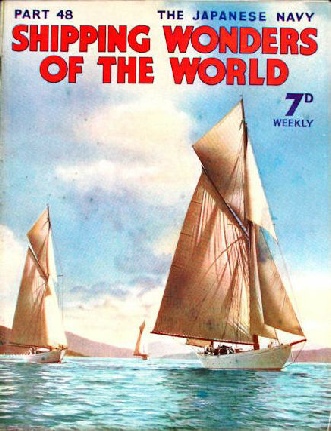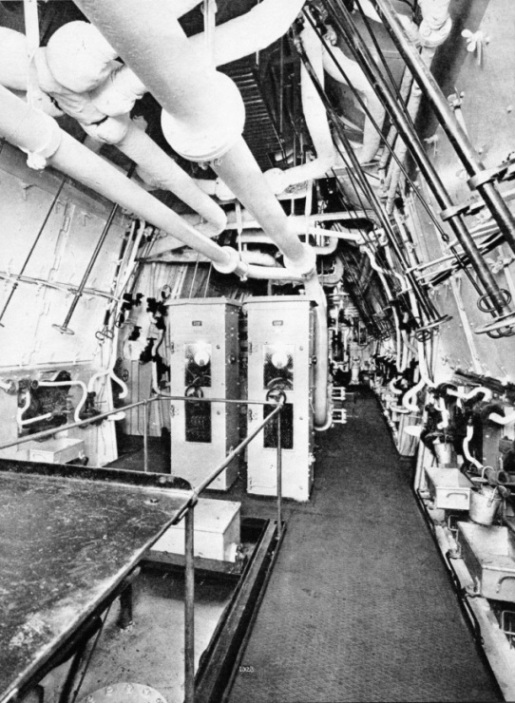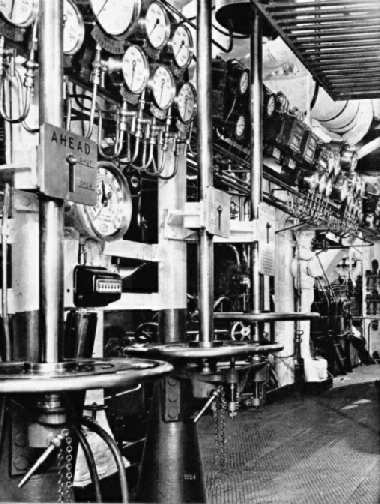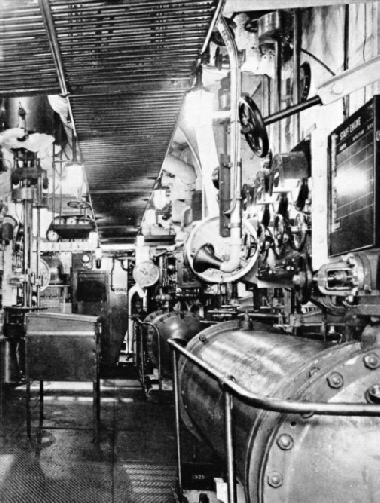
© Shipping Wonders of the World 2012-



Part 48
Part 48 of Shipping Wonders of the World was published on Tuesday 5th January 1937.
It included a centre photogravure supplement illustrating the aspects of the work of the marine engineer. It formed part of the article on The Marine Engineer.
The Cover
This week’s cover is a hand-tinted picture taken from a Kodak snapshot. It shows the yachts Vadura, Finmara, and Fiona on the Clyde near Rothesay.

Contents of Part 48
Battle of the Falklands
The story of the fate of von Spee’s German squadron off the Falkland Islands, concluded from part 47.
This chapter is the seventh article in the series on Decisive Naval Actions.
Life in the East Indiamen
Famous though the vessels were, surprisingly little comfort could be obtained on a voyage to India or China in an East Indiaman, despite the exceptionally high prices paid for a passage. The East India Company, founded in 1600, was responsible for the development of India until the Government took control in 1858. The Indiamen were notoriously slow sailers, and the long voyage round the Cape of Good Hope was monotonous and uncomfortable as well as exceedingly expensive.
The Marine Engineer
An apprenticeship of five years is necessary before a boy is eligible to become a ship’s engineer. Once he has passed his examinations and gained his certificates he has before him many opportunities of self-advancement. For the ambitious youngster who is interested in machinery and hankers after a sea-going career, marine engineering offers many attractions. This chapter is a comprehensive review of the best means of obtaining training and the sort of posts that are open in this branch of seafaring.
The article is the fifth in the series Going to Sea.
The Marine Engineer (photogravure supplement)
In the Engine-Room of the Empress of Britain
IN A GREAT LINER the orderly maze of machinery is often awe-inspiring. This photograph shows the central platform in the forward engine-room of the Canadian Pacific liner Empress of Britain (42,348 tons gross). The engineer who aspires to control marine machinery has to pass at least two Board of Trade examinations. The first is that for the second-class certificate of competency, for which he cannot sit until he has been eighteen months in charge at sea under a senior engineer. The second examination is for his chief engineer’s ticket. The applicant must have been in charge of a watch with a second-class ticket for at least a year. The most ambitious marine engineers will sit also for their extra chief engineer’s certificate, which proclaims the holder to be a first-class man.
Britain’s Canal System
The victim of uncontrolled speculation before the coming of railways, the British canal system was never used to the best advantage. Co-operation and enterprise, however, are doing much to revive the latent commercial value of canal transport. Towards the end of the eighteenth century there was a craze for canal-building and an enormous number of canals were built in Great Britain. In this chapter the smaller canals which are important to British transport and also as links to the sea, are described.
The Imperial Japanese Navy
In little more than fifty years Japan has grown from small beginnings into a naval Power of major importance with a fleet which, in efficiency, as well as in numbers, rivals the navies of any part of the world. The first steamship to be built in Japan was an armed wooden cruiser laid down in Nagasaki in 1860. In the next few years Japan bought a number of warships from America and Europe. Others were built for her by British firms. Towards the end of the nineteenth century, however, her navy included many ships of Japanese construction. By this speedy assimilation of all that was best in the naval practice of other countries, Japan developed in fifty years a navy that was as efficient as those which other countries had built up in a hundred years.
The article is the third in the series on the Fleets of Foreign Powers.
Day Service Cross-Channel Packet
A description of the Canterbury, a Southern Railway ship of 2,910 tons gross. She was one of the first of a new type of day service ship and embodied at the time of her completion many innovations in arrangement. Completed at Dumbarton in 1929, she has a length of 329 ft 7 in between perpendiculars, a beam of 47 ft 1 in and a depth of 16 ft 10 in.
This is the thirty-eighth article in the series on Merchant Ship Types.
Safety at Sea
The risk of serious danger from accidents at sea has been considerably reduced by the introduction of strict regulation governing the loading of ships and by the perfection of such equipment as lifeboats, wireless and the like in every type of merchant vessel. In bygone days the provisions for safety at sea were few, and badly enforced. Happily the world is more enlightened nowadays, and conscientious shipowners will take every care to see that their vessels are perfectly seaworthy. Lifebelts, boats, wireless, loadline regulations, watertight bulkheads and so forth all minimize the risk of a disaster at sea, and there is no reason for anybody to be fearful of a sea voyage. This chapter is concluded in part 49.
The Marine Engineer: Photogravure Supplement
WATER TUBE BOILERS in the Monarch of Bermuda (22,424 tons gross). There are eight of these boilers, arranged in groups of four, and they supply power to turbo-generators for the electric propulsion of the ship. The electricians on board a ship are not certificated men, but they must have served their apprenticeship and have obtained practical experience on land. Each is under the engineer in charge of the watch and has to undertake all kinds of detail work connected with the electrical side. Electricians must be fully qualified, but they can never rise above the rank of senior electrician.


